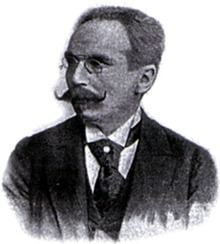Name Zygmunt Gorgolewski | Role Architect | |
 | ||
Structures Lviv Theatre of Opera and Ballet | ||
Zygmunt Gorgolewski (February 14, 1845 – July 6, 1903) was a Polish architect, renowned for his construction of the Grand Theatre in Lwów (Lviv).
Gorgolewski was born in Solec (Schulitz), Province of Posen, Kingdom of Prussia. Between 1866 and 1871 he studied in Berlin at the Royal Building Academy. During his studies, Gorgolewski also supervised the construction of Hanover Train Station in Berlin. After graduating, for six years he worked as an assistant in his alma mater. After that he became an advisor at the German Ministry of Public Works, official royal palace architect and architecture inspector in Halle. Gorgolewski was one of the most notable supporters of historicism in architecture in the Kingdom of Prussia and then the German Empire.
Among his projects were two versions of the future Reichstag building, which he proposed in 1872 and then in 1882. His projects were among merely 20 chosen by the committee out of more than 100. However, in the end his ideas for these projects were refused. At the same time, Gorgolewski was awarded with the construction of Kaiser Wilhelm's Bridge. Other, more successful, projects include the plans of refurbishment of royal palaces in Berlin and Kiel, expansion of University Hospitals in Halle and Bonn, expansion of Bad Oeynhausen spa in Westphalia. In addition, he was the main architect of the Protestant cathedral in Berlin, Belle Vue palace, courthouses in Opole (Oppeln) and Olsztyn (Allenstein), as well as prisons in Świdnica (Schweidnitz) and Chorzów (Königshütte).
In the Greater Poland region, Gorgolewski conducted the construction of many notable palaces both in and around Poznań. His works include:
He was also appointed as the main architect of the refurbishment of the palace of Ferdynand Radziwiłł in Ołyka, Volhynia. During his stay there, Gorgolewski for the first time visited Vilnius, Kraków, Kiev and Lviv. The latter city enjoyed a period of fast expansion and in 1875 Gorgolewski took part in the contest for the project of the future Galician Sejm. His project was the most disputed and highly praised, but it was finally turned down, mostly due to financial reasons.
In 1879, Gorgolewski married Helena née Hulewicz. He was also an active member of many architectural juries across partitioned Poland. Among others, he was the member of the jury during the contest for the project of Kraków Old Theatre (1889), the bank in Czerniowce and St. Elisabeth's Church in Lviv. In 1893 he moved to Lviv, where he was chosen as the main architect of the Grand Theatre (1897–1900). To avoid being accused of using his well-established position in society, Gorgolewski prepared his winning project of the theatre in secret and then sent it under a false name from Leipzig. Other notable building of his authorship was the Industrial School in the same city.
Gorgolewski died in Lwów and was buried in the Łyczaków Cemetery.
